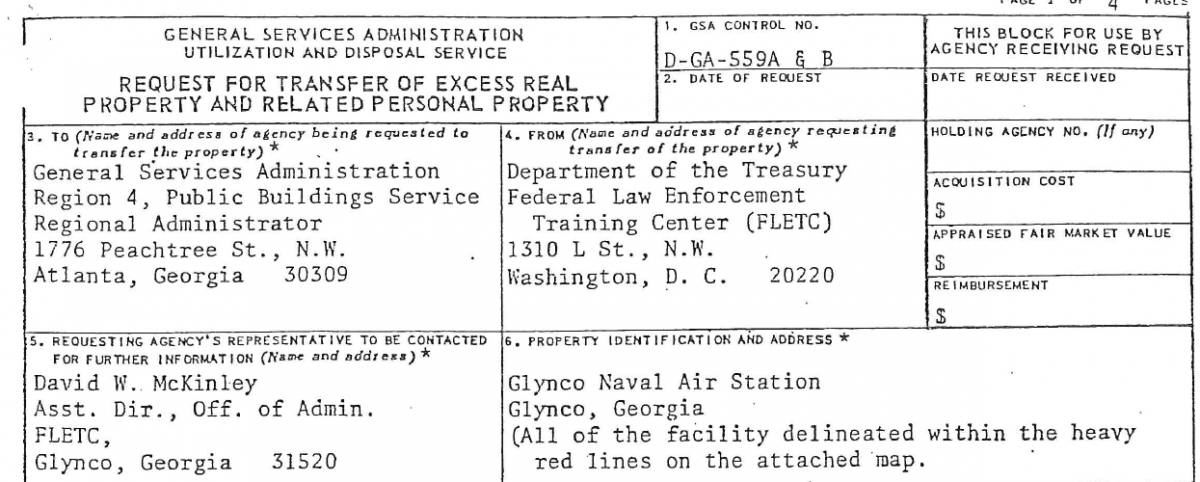In keeping with the 50th anniversary of FLETC, it seems important to start at the beginning.
On June 30, 1970, then Secretary of the Treasury David M. Kennedy signed Treasury Department Order Number 217. This order specified the establishment of the Consolidated Federal Law Enforcement Training Center (CFLETC) as “an organizational entity within the Department of the Treasury to function as an interagency training facility.”
CFLETC operated out of the two top-level floors in an office building located on L Street, NW, in Washington, D.C. Because this facility was not conducive to law enforcement training, instructors and students typically traveled to nearby facilities for firearms and driver training. The newly established CFLETC required an operational facility to support the consolidated training model. CLETC staff and architects developed plans for a consolidated training facility that would be located in Beltsville, Maryland. There were constant changes to the design, the final cost estimate of which was 400% over the original. As a result, in 1974 Congress ordered the Department of the Treasury and the General Services Administration (GSA) to look at already existing facilities to house the new CFLETC.
Glynco Naval Air Station was established in 1942 and originally hosted Airship Patrol Squadron 15 of Fleet Airship One, a fleet of Lighter than Airships (LTA), or blimps. The base played an important role in defense of the east coast during World War II. Following the war, Glynco transitioned from dirigibles to jets and eventually became a premier training facility for the Navy’s Air Traffic Control Schools.
Glynco Naval Air Station officially closed in 1974, creating a major financial loss for Brunswick, Georgia, and the surrounding areas. The naval air station had been a dependable source of stable economic activity for the area since the 1940s. The sudden change had a sharp impact on the Golden Isles and created uncertainty regarding the area’s economic future.
Congressman Bo Ginn, First District of Georgia, recognized an opportunity for the future CFLETC. He joined with Senators Herman Talmadge and Sam Nunn to approach the Senate Public Works Committee for consideration to review closed military facilities as the future location for CFLETC. CFLETC staff completed a survey of 118 closed military installations, 21 of which were selected for site visits. Out of the final six locations, Glynco Naval Air Station was the only site chosen for a second visit. In Georgia, both former Albany Air Station and Glynco Air Station were in competition. The committee noted the existing facilities at Glynco Naval Air Station were conducive to the needs of CFLETC, and of the existing structures, were newer than other sites under consideration. Therefore, the selection of the Glynco facility would result in an estimated cost avoidance of 15-20 million dollars to the U.S. Treasury.
In March 1975, Congress and the Department of the Treasury approved the former Glynco Naval Air Station as the new home of CFLETC. On September 2, 1975, GSA transferred Glynco Naval Air Station to the Department of the Treasury, and Congress approved 28.1 million dollars for renovations and construction to transform the former air station to the required training venues.
CFLETC staff took control of the Glynco site in July 1975, and the site became operational on September 12, 1975, with 26 participating agencies. The first class also arrived on this day. The two months between feet-on-the-ground and opening-for-business was a welcomed challenge that resulted in CFLETC establishing operational training and office facilities, instituting meal service and dining capabilities, and staffing the Center with personnel to execute the mission.
In his 1996 book The Trainers: The Federal Law Enforcement Training Center and the Professionalization of Federal Law Enforcement, Frederick Calhoun quoted Physical Training Instructor Frank Graves as saying, “We were excited about the possibilities and the opportunities. That’s what kept us going. We did a lot of everything. We were recreational specialists, we were bus drivers. We were the jack of all trades at the time until the Center got going and started hiring people with those specialties.”
Once CFLETC established its residence at Glynco, the organization dropped the ‘C’ and was renamed Federal Law Enforcement Training Center.
References:
Unattributed. Federal Law Enforcement Training Possible at Glynco. The Brunswick News, January 31, 1975
Calhoun, Frederick S. The Trainers: The Federal Law Enforcement Training Center and the Professionalization of Federal Law Enforcement, USG Printing Office, 1996.






###
Federal Law Enforcement Training Centers
Protocol & Communications Office
Contact: 912-267-2447

